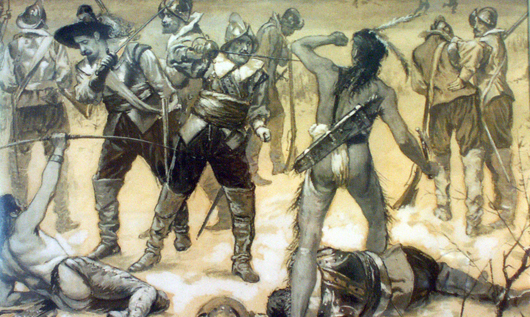
MYSTIC, Conn. (AP) – Most local residents are familiar with the massacre and burning of the Pequot Indian fort in 1637 by English forces and their Native American allies.
What is lesser known is that as the surviving 75 British soldiers and 200 allies retreated toward ships on the Thames River, they had to fight off fierce attacks from 300 Pequots and at one point may have burned a smaller Indian village they came across.
Now Kevin McBride, the director of research at the Mashantucket Pequot Museum and Research Center, with help from 20 college students from across the country, is spending the summer in Pequot Woods retracing the steps that Capt. John Mason and his men took during that retreat.
“This is a real window into that time period,” McBride said recently as his search team worked deep in the woods off a trail that leads to Mystic Meadow Lane.
So far the team has found musketballs, gun parts, bent arrow points, gun flints, tools, buttons and other artifacts that have helped them map the soldiers’ steps. Using metal detectors, team members meticulously examine grids that are 10 meters square before moving on to adjacent areas. They have also been digging test pits, hoping to find evidence of the destroyed village.
“Right where we’re standing they were fighting off repeated Pequot attacks,” said McBride, whose team uses historic documents and descriptions of the battle to gather clues about where to search.
“I’m not sure whether we’re getting good or we’re lucky, but I don’t care,” said McBride, who heads the University of Connecticut’s Field School in Battlefield Archaeology. “The challenge is putting yourself into the head of a 17th-century English commander as well as the Pequots.”
So far McBride and his team have completed a mile of the search and have two more to go, as the retreat stopped short of the Thames. They plan to continue their work through the fall.
Two student researchers using metal detectors that can probe 20 inches deep recently got a hit on a metal object. After a few minutes of digging and screening soil, they found an irregularly shaped iron object encrusted in dirt. Turning it in his fingers, McBride placed it a sealed plastic bag.
“It’s definitely worth an x-ray,” he said. “This is the fun part of the discovery. You never know what you’ll find out here.”
In another area, researchers dug test pits to search for evidence of the destroyed village such as pottery, stone tools and English trade goods.
“The village would be an incredible find,” McBride said, showing off a stone spear point from one of the test holes that he estimated was made between the years 1000 and 1600.
The project is being funded with a $60,000 grant from the National Park Service’s American Battlefield Protection Program along with continued support and funding from the Mashantucket museum.
With funding from both groups, McBride and his team completed an archaeological study of the Mystic Fort off Pequot Avenue two years ago and mapped a location in Old Mystic where the English and their allies camped before the massacre.
The result of the studies has been documented in 400-page reports for the park service.
“We’ve learned more about the Pequot War and the colonists in the past four years than in the previous 25,” McBride said. “The archaeology and the historic narrative coming together begin to tell you the story.”
___
Information from: The Day, http://www.theday.com
Copyright 2012 Associated Press. All rights reserved. This material may not be published, broadcast, rewritten, or redistributed.
AP-WF-06-23-12 1504GMT
ADDITIONAL IMAGE OF NOTE


